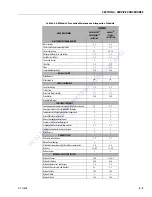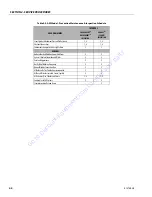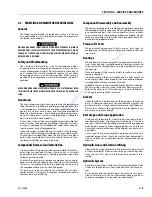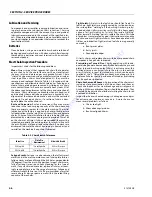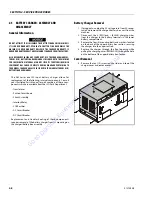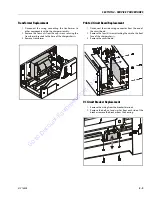
SECTION 2 - SERVICE PROCEDURES
2-16
31215808
2.8
HYDRAULIC LIFT CYLINDER - REMOVAL,
INSPECTION AND REBUILD
HYDRAULIC CYLINDERS ARE DESIGNED TO HOLD HYDRAULIC FLUID UNDER
HIGH PRESSURE. BE SURE ALL APPROPRIATE MEASURES ARE TAKEN TO
RELIEVE RESIDUAL PRESSURE IN THE CYLINDER BEFORE DISCONNECTING
LINES.
Cylinder Removal
1. Disconnect power source.
(Remove the DC power pack/
charger assembly from back of mast, if equipped)
.
2. Remove ground control (pump) cover.
3. Disconnect the hydraulic lines at the pump.
4. Using suitable lifting equipment, lay machine down hori-
zontal onto the back of mast to allow access to the bot-
tom of the machine.
(Preferably on an elevated work
surface capable of supporting the full weight of the
machine)
.
5. Slide
(extend)
the mast out the top about 2 ft. to 3 ft. to
allow access to the cylinder attach setscrew on the attach
block at the top of mast section-2.
6. Remove the cylinder attach setscrew from the attach
block on top of mast section-2.
(Lowest set of sheaves)
.
7. Remove the protective mast cylinder/hydraulic line cover
plate from the base frame under the mast.
NOTE:
(Use a container to catch the hydraulic oil from cylinder
and hydraulic lines in next step, discard oil).
8. Remove the hydraulic lines from the mast cylinder.
9. Remove the snap-ring from either end of the cylinder
mount pin running through the cylinder valve block.
While supporting the cylinder remove the mounting pin.
NOTE:
In the following step the mast cylinder mount will be
shimmed tight in the mast.
10. Remove the cylinder mast mount from the mast.
NOTE:
In the following step the mast cylinder may be tight in the
cylinder attach block at the top of the mast.
11. Pull the mast cylinder out of the mast.
Cylinder Disassembly
1. Before disassembling the cylinder, clean away all dirt and
foreign substances from openings, particularly the head
area.
NOTE:
Always protect the chrome surface of the cylinder rod dur-
ing assembly and disassembly. Any damage to this surface
will require replacement of the rod.
2. Extend the rod until the piston bottoms out against the
cylinder head.
3. Compress the head retraining ring enough to allow the
cylinder head to be removed.
4. Carefully slide the head/rod/piston assembly out of the
cylinder tube. A gentle tap on the head assembly may be
required to remove the head from the cylinder tube.
5. Place the head/rod/piston assembly on a surface that will
not damage the chrome.
6. Remove the piston locknut and separate the piston from
the rod.
7. Slide the head off the rod from the piston end.
NOTE:
When removing the old seals use only blunt tools, be sure
there are no sharp edges that may damage the seal
grooves during removal. Scratching the groove may cause
by-pass.
8. Remove and discard all old seals.
Lift Cylinder Component Inspection
Cylinder Rod
There should be no scratches or pits deep enough to catch the
fingernail. Pits that go to the base metal are unacceptable.
Scratches that catch the fingernail but are not to the base
metal, less than 0.5 inch long and primarily in the circumferen-
tial direction are acceptable provided they cannot cut the rod
seal. Chrome should be present over the entire surface of the
rod and the lack thereof is unacceptable. In the event that an
unacceptable condition occurs, the rod should be repaired or
replaced.
Cylinder Head
Visually inspect the inside bore for scratches or polishing.
Deep scratches are unacceptable. Polishing indicates uneven
loading and when this occurs, the bore should be checked for
out-of-roundness. If out-of-roundness exceed 0.007 in., this is
unacceptable. Check the condition of the dynamic seals
(wiper, rod seals) looking particularly for metallic particles
embedded in the seal surface. It is normal to cut the static seal
on the retaining ring groove upon disassembly. Remove the
rod seal, static o-ring and backup and rod wiper. Damage to
the seal grooves, particularly on the sealing surfaces, is unac-
ceptable. In the event that an unacceptable condition occurs,
the head should be replaced.
Go
to
Discount-Equipment.com
to
order
your
parts


